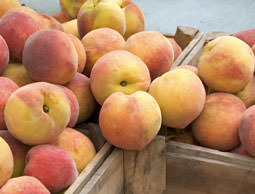
 Courtesy iStockphoto/Thinkstock It’s important not to store peaches with greens, according to the “2012 Production Guide for Storage of Organic Fruits and Vegetables” because peaches produce ethylene, which can damage the greens. |
Organic tomatoes and melons are selling fast at the farmers’ market this time of year, and because many organic fruit and vegetable farmers sell their produce shortly after harvest, best practices for long-term storage haven’t been a looming concern.
Now with organic produce reaping a growing marketplace share, farmers who can keep their crops fresh longer will benefit from more marketing options. To help guide farmers in the process, Cornell University, the New York State Pest Management program, and the New York State Department of Agriculture & Markets recently released the “2012 Production Guide for Storage of Organic Fruits and Vegetables.”
Authors Christopher Watkins and Jacqueline Nock, of Cornell’s horticulture department compiled the clear and comprehensive manual, providing the information and advice farmers need to store their crops with the same care they put into growing them, including:
- the shelf life of specific fruits and vegetables
- types of ethylene-producing fruits and vegetables and the effects this natural gas, which is essential to ripening, has on the quality of stored produce
- chemical processes some produce undergo as it ages
- best storage temperatures and methods for cooling a storage area
- handling considerations during harvest
- approved chemicals for organic post-harvest systems
The guide can be used to complement NYS IPM’s updated 2012 organic grower guides and can be downloaded and printed for free at www.nysipm.cornell.edu/organic_guide/default.asp.
Read more about post-harvest produce storage:
- 6 Food-storage Alternatives to Root Cellars
- 8 Ways to Prepare a Root Cellar for Food Storage
- 22 Foods You Can Store in Root Cellars
- Root Cellars
- Build a Custom-made Root Cellar




